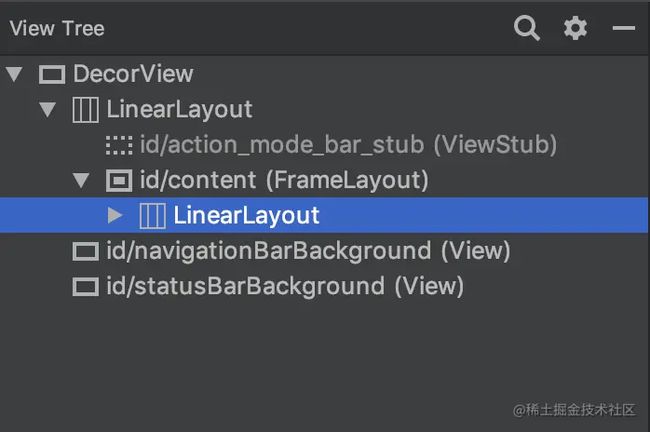Android事件分发之前流程详解
- 首先我们知道dispatchTouchEvent()是由父View传给子View的一级一级分发到子View,这样我们就知道事件是由我们定义的最外层View传递过来的
打开Android Studio 运行一个项目 然后选择Android Studio上方的Tools -> Layout Inspector -> 选择你的项目,然后会生成一个li文件
在View Tree可以清楚的看见你的页面布局结构,图中蓝色的部分就是setContentView 的布局文件 我们看到除了自己的布局文件外,还有一些系统定义的布局,在这些布局中,最外层的View就是DecorView 根据事件分发的机制可以知道,事件是最外层View 即DecorView 分发给子View的
2. 那又是谁分发给DecorView 的呢?
要解决这个问题,就要问DecorView 有没有父View了吗? 看上面那张图,发现DecorView确实没有父View了,但是他却有个抽象父亲ViewRootImpl 看View的源码
//指定View的父亲
void assignParent(ViewParent parent) {
if (mParent == null) {
mParent = parent;
} else if (parent == null) {
mParent = null;
} else {
throw new RuntimeException("view " + this + " being added, but"
+ " it already has a parent");
}
}
那就看ViewRootImpl 有没有指定父亲 ,请看ActivityThread源码,来一步一步看是如何设置的 ActivityManagerService通过进程间通信,执行ApplicationThread的scheduleResumeActivity() ->sendMessage->H handller->handleResumeActivity()
final void handleResumeActivity(IBinder token,
boolean clearHide, boolean isForward, boolean reallyResume, int seq, String reason) {
//省略
ActivityClientRecord r = mActivities.get(token);
r = performResumeActivity(token, clearHide, reason);
//省略
if (r != null) {
//省略
if (r.window == null && !a.mFinished && willBeVisible) {
r.window = r.activity.getWindow();
View decor = r.window.getDecorView();
//省略
ViewManager wm = a.getWindowManager();
//省略
if (a.mVisibleFromClient) {
if (!a.mWindowAdded) {
a.mWindowAdded = true;
//这里 通过ViewManager 的 addView 把DecorView加入了
wm.addView(decor, l);
} else {
//省略
}
}
} else if (!willBeVisible) {
//省略
}
//省略
} else {
//省略
}
}
wm.addView(decor, l); 这里通过ViewManager把DecorView加入了 ok 继续看a.getWindowManager() 的实现类是WindowManagerImpl ->WindowManagerImpl.addView() ->WindowManagerGlobal.addView() 源码
public void addView(View view, ViewGroup.LayoutParams params,
Display display, Window parentWindow) {
//省略
ViewRootImpl root;
View panelParentView = null;
synchronized (mLock) {
//省略
root = new ViewRootImpl(view.getContext(), display);
//省略
try {
//执行ViewRootImpl.setView()方法把view(DecorView) 设置进去
root.setView(view, wparams, panelParentView);
} catch (RuntimeException e) {
//省略
}
}
}
执行了ViewRootImpl.setView() 把DecorView 设置进去
public void setView(View view, WindowManager.LayoutParams attrs, View panelParentView) {
synchronized (this) {
if (mView == null) {
mView = view;
//省略
int res; /* = WindowManagerImpl.ADD_OKAY; */
try {
//省略
//这里mInputChannel 很重要,事件分发就是通过这个类来的
res = mWindowSession.addToDisplay(mWindow, mSeq, mWindowAttributes,
getHostVisibility(), mDisplay.getDisplayId(),
mAttachInfo.mContentInsets, mAttachInfo.mStableInsets,
mAttachInfo.mOutsets, mInputChannel);
} catch (RemoteException e) {
//省略
} finally {
//省略
}
//省略
//把mInputChannel放入WindowInputEventReceiver
if (mInputChannel != null) {
if (mInputQueueCallback != null) {
mInputQueue = new InputQueue();
mInputQueueCallback.onInputQueueCreated(mInputQueue);
}
mInputEventReceiver = new WindowInputEventReceiver(mInputChannel,
Looper.myLooper());
}
//这里把ViewRootImpl设置为DecorView的父亲
view.assignParent(this);
//省略
}
}
}
最后发现 view.assignParent(this);把ViewRootImpl设置为DecorView的父亲 ViewRootImpl实现了ViewParent 却没有继承View,说明他有父亲的功能却不进行界面绘制
到这里,说明了
DecorView还有一个不是View的父亲ViewRootImpl
在执行setView方法 设置了mInputChannel这个对象,这个便是输入事件的传输管道,用WindowInputEventReceiver 包裹了InputChannel 在事件发生的时候,就是通过InputChannel 来和ViewRootImpl交互的,至于如何通过c++ 的InputReader 和InputDispatcher 来进行分发的这里不做过多讨论,还是讨论Java代码的执行过程
3. 重点来看WindowInputEventReceiver
当输入事件发生的时候,依次执行onInputEvent()->enqueueInputEvent()->doProcessInputEvents()->deliverInputEvent()->stage.deliver(q);->apply(q, onProcess(q));
根据输入事件的类型
stage:InputStage有不同的事件类型,按键事件,屏幕触摸事件,等等,我这里走屏幕触摸事件ViewPostImeInputStage.onProcess()->processPointerEvent()->mView.dispatchPointerEvent(event)这里终于走到DecorView的dispatchPointerEvent(event)事件了
4. 继续看DecorView 执行dispatchPointerEvent(event)->dispatchTouchEvent(event)
DecorView 重写了dispatchTouchEvent(event)
@Override
public boolean dispatchTouchEvent(MotionEvent ev) {
final Window.Callback cb = mWindow.getCallback();
return cb != null && !mWindow.isDestroyed() && mFeatureId < 0
? cb.dispatchTouchEvent(ev) : super.dispatchTouchEvent(ev);
}
如果Window.Callback不为空,且mWindow没有销毁mFeatureId<0 会执行Window.Callback的dispatchTouchEvent(ev) 我们知道DecorView的window是PhoneWindow,继续查看PhoneWindow里面的Callback是在什么时候,哪里设置的
final void attach(Context context, ActivityThread aThread,
Instrumentation instr, IBinder token, int ident,
Application application, Intent intent, ActivityInfo info,
CharSequence title, Activity parent, String id,
NonConfigurationInstances lastNonConfigurationInstances,
Configuration config, String referrer, IVoiceInteractor voiceInteractor,
Window window, ActivityConfigCallback activityConfigCallback) {
//省略
mWindow = new PhoneWindow(this, window, activityConfigCallback);
mWindow.setWindowControllerCallback(this);
//设置当前Activiy为Callback
mWindow.setCallback(this);
//省略
}
在Activity的attach()中,我们知道了 设置了当前Activity为Callback所以会执行Activity的dispatchTouchEvent()
public boolean dispatchTouchEvent(MotionEvent ev) {
if (ev.getAction() == MotionEvent.ACTION_DOWN) {
onUserInteraction();
}
if (getWindow().superDispatchTouchEvent(ev)) {
return true;
}
return onTouchEvent(ev);
}
所以执行顺序是 PhoneWindow.superDispatchTouchEvent () 如果没有消费,才会执行Activity. onTouchEvent () PhoneWindow.superDispatchTouchEvent ()->DecorView.superDispatchTouchEvent()->ViewGroup.dispatchTouchEvent()
至此 事件的分发终于走到了
dispatchTouchEvent()
